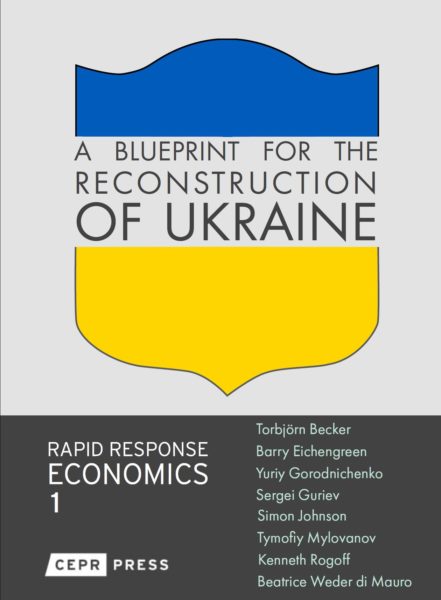On February 24, 2022, Russia invaded Ukraine. Thousands of civilians were killed; millions of people were displaced, including 2 million children displaced outside Ukraine; and the extent of the destruction in the country is already astonishing. The United Nations General Assembly has condemned Russia’s war of aggression in Ukraine.
Although the outcome of the war is uncertain, one can begin to think about the future reconstruction of Ukraine. In a new e-book, part of the CEPR Rapid Response Economics series, a group of economists (Torbjörn Becker from SITE, Barry Eichengreen from UC Berkeley, Sergei Guriev from Sciences Po, Simon Johnson from MIT, Tymofiy Mylovanov from KSE, Kenneth Rogoff of Harvard, Beatrice Weder di Mauro of GIG, and myself) outline ideas for the design and requirements of this effort. This group of economists builds on previous experiences with post-war reconstruction (eg, the Marshall Plan after World War II, the reunification of Germany, and the reconstruction of Iraq and Afghanistan) and reconstruction following natural disasters.
As a first step, economists are reviewing the current situation in Ukraine. In short, the economy suffered a major negative shock, with GDP shrinking by at least 30%. Despite massive economic disruptions and growing fiscal challenges, government functions are largely operational. Ukrainians have a strong sense of purpose and unity. Given the level of economic development and proximity to the EU, after the end of hostilities, Ukraine is likely to resemble Europe after World War II, rather than Iraq or Afghanistan in 2002/03.
Several countries and international institutions have pledged to support the reconstruction of Ukraine. This support is very diverse and ranges from bilateral aid to assistance from multilateral institutions (eg the World Bank) to support from private sources (Ukrainian diaspora, charities, individuals and businesses). There is a discussion about the use of confiscated Russian assets, as well as current income from Russian energy to pay for reconstruction and compensation (for example, Tsyrennikov).
Economists argue that international aid for reconstruction efforts should be based on the following principles to ensure Ukraine’s long-term success. First, Ukraine should be on the path to EU membership in order to provide a strong incentive for the country to reform and modernize. Second, aid should be swift to ensure that it is received in the critical post-war period, when Ukraine does not have its own resources. However, aid should also be conditional on ensuring that money is well spent and that it directs reconstruction towards the use of best practices, which includes efforts to radically reduce corruption. Third, aid should be based on grants rather than loans, in order to avoid debt sustainability issues in the future. Fourthly, coordination between funding sources is essential to avoid waste, delays and duplication. Fifth, reconstruction offers a unique opportunity to radically improve Ukraine’s productive capacity to bring it closer to the technological frontier (including green technologies), to lay the foundations for long-term growth, and to integrate Ukraine even more closely into the global economy. Aid should focus on increasing the productivity capacity of the economy and stimulating a high rate of investment (eg for new machinery / equipment, infrastructure, training / human capital, technical assistance, etc.) and by strengthening human capital. . Finally, because the aid will be effective only if it is aligned with the interests of Ukraine, Ukraine must “own” its own reconstruction.
Based on these principles, the authors of the plan propose that the aid be administered by an autonomous, EU-affiliated or authorized agency, independent of, but accountable to, multilateral, bilateral and non-governmental donors. This agency may be similar to the Economic Cooperation Administration that administered the Marshal Plan. The establishment of a new EU affiliated agency will help avoid mission drift, minimize bureaucracy and the inertia of existing institutions, minimize political influence (e.g. Russia is a shareholder in the IMF, World Bank and European Bank for Reconstruction and Development), avoid led reconstruction of donors and attract a fresh, motivated and high-morale cadre. This agency should have significant decision-making autonomy in order to minimize political influence and maintain
